The Effectiveness of a Pressure Ulcer Intervention Program
VerifiedAdded on 2022/08/20
|6
|1997
|12
AI Summary
Contribute Materials
Your contribution can guide someone’s learning journey. Share your
documents today.
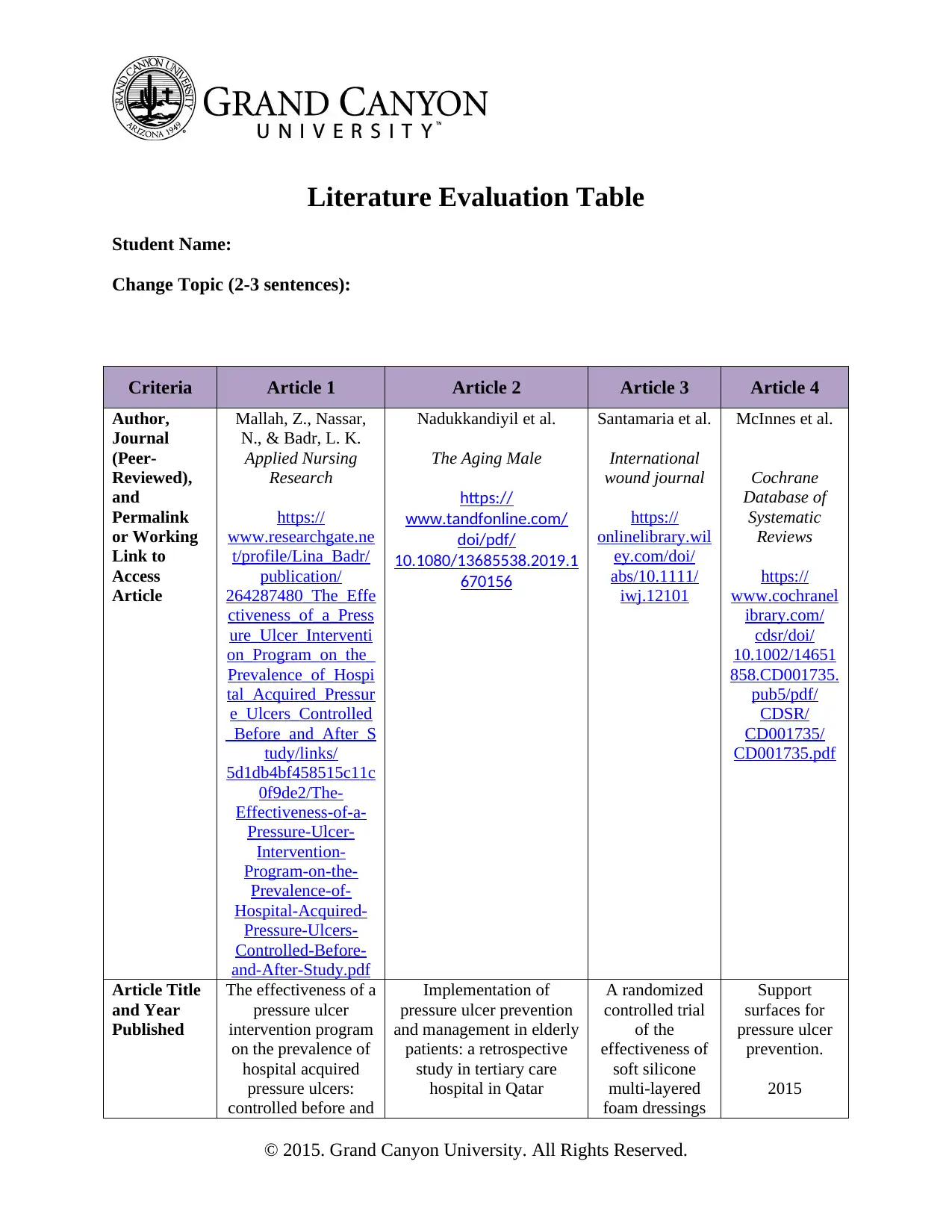
Literature Evaluation Table
Student Name:
Change Topic (2-3 sentences):
Criteria Article 1 Article 2 Article 3 Article 4
Author,
Journal
(Peer-
Reviewed),
and
Permalink
or Working
Link to
Access
Article
Mallah, Z., Nassar,
N., & Badr, L. K.
Applied Nursing
Research
https://
www.researchgate.ne
t/profile/Lina_Badr/
publication/
264287480_The_Effe
ctiveness_of_a_Press
ure_Ulcer_Interventi
on_Program_on_the_
Prevalence_of_Hospi
tal_Acquired_Pressur
e_Ulcers_Controlled
_Before_and_After_S
tudy/links/
5d1db4bf458515c11c
0f9de2/The-
Effectiveness-of-a-
Pressure-Ulcer-
Intervention-
Program-on-the-
Prevalence-of-
Hospital-Acquired-
Pressure-Ulcers-
Controlled-Before-
and-After-Study.pdf
Nadukkandiyil et al.
The Aging Male
https://
www.tandfonline.com/
doi/pdf/
10.1080/13685538.2019.1
670156
Santamaria et al.
International
wound journal
https://
onlinelibrary.wil
ey.com/doi/
abs/10.1111/
iwj.12101
McInnes et al.
Cochrane
Database of
Systematic
Reviews
https://
www.cochranel
ibrary.com/
cdsr/doi/
10.1002/14651
858.CD001735.
pub5/pdf/
CDSR/
CD001735/
CD001735.pdf
Article Title
and Year
Published
The effectiveness of a
pressure ulcer
intervention program
on the prevalence of
hospital acquired
pressure ulcers:
controlled before and
Implementation of
pressure ulcer prevention
and management in elderly
patients: a retrospective
study in tertiary care
hospital in Qatar
A randomized
controlled trial
of the
effectiveness of
soft silicone
multi‐layered
foam dressings
Support
surfaces for
pressure ulcer
prevention.
2015
© 2015. Grand Canyon University. All Rights Reserved.
Student Name:
Change Topic (2-3 sentences):
Criteria Article 1 Article 2 Article 3 Article 4
Author,
Journal
(Peer-
Reviewed),
and
Permalink
or Working
Link to
Access
Article
Mallah, Z., Nassar,
N., & Badr, L. K.
Applied Nursing
Research
https://
www.researchgate.ne
t/profile/Lina_Badr/
publication/
264287480_The_Effe
ctiveness_of_a_Press
ure_Ulcer_Interventi
on_Program_on_the_
Prevalence_of_Hospi
tal_Acquired_Pressur
e_Ulcers_Controlled
_Before_and_After_S
tudy/links/
5d1db4bf458515c11c
0f9de2/The-
Effectiveness-of-a-
Pressure-Ulcer-
Intervention-
Program-on-the-
Prevalence-of-
Hospital-Acquired-
Pressure-Ulcers-
Controlled-Before-
and-After-Study.pdf
Nadukkandiyil et al.
The Aging Male
https://
www.tandfonline.com/
doi/pdf/
10.1080/13685538.2019.1
670156
Santamaria et al.
International
wound journal
https://
onlinelibrary.wil
ey.com/doi/
abs/10.1111/
iwj.12101
McInnes et al.
Cochrane
Database of
Systematic
Reviews
https://
www.cochranel
ibrary.com/
cdsr/doi/
10.1002/14651
858.CD001735.
pub5/pdf/
CDSR/
CD001735/
CD001735.pdf
Article Title
and Year
Published
The effectiveness of a
pressure ulcer
intervention program
on the prevalence of
hospital acquired
pressure ulcers:
controlled before and
Implementation of
pressure ulcer prevention
and management in elderly
patients: a retrospective
study in tertiary care
hospital in Qatar
A randomized
controlled trial
of the
effectiveness of
soft silicone
multi‐layered
foam dressings
Support
surfaces for
pressure ulcer
prevention.
2015
© 2015. Grand Canyon University. All Rights Reserved.
Secure Best Marks with AI Grader
Need help grading? Try our AI Grader for instant feedback on your assignments.

after study. , 2015 2019 in the prevention
of sacral and
heel pressure
ulcers in trauma
and critically ill
patients: the
border trial.
2015
Research
Questions
(Qualitative)
/Hypothesis
(Quantitativ
e), and
Purposes/Ai
m of Study
The research
questions include the
prevalence of HAPU
before and after
intervention and the
risk factors. The
purpose of this study
was to determine the
efficiency of
multifaceted
interventions in
prevention of
pressure sores in the
elderly to find which
method is effective.
The purpose of the study is
to look for the risk factors,
demographics and clinical
care in patients in risk of
pressure ulcers.
The purpose of
the study is to
measure the
effectiveness of
silicone foam
dressing in
preventing
pressure ulcers
in critical
patients.
The aim of this
systematic
review is to
find out how
much pressure
relieving
mattresses are
successful in
preventing
pressure ulcers.
Design (Type
of
Quantitative,
or Type of
Qualitative)
Qualitative data was
collected. It consists
of an evaluation
prospective research
design.
The study was conducted
by a retrospective
longitudinal study.
The study is an
open
randomized
controlled trial.
The research
collected
secondary data
from databases
like CINAHL,
MEDLINE and
EMBASE.
Setting/
Sample
The sample consisted
of 486 patients in
long term care.
The sample consisted of
90 patients with among
half of them having
pressure ulcers.
The sample
consisted of the
patients
admitted in ED
due to critical
injuries. There
were 220
patients in each
group.
59 studies were
collected and
similar studies
were pooled.
Any patient
group was
considered.
Methods:
Intervention/
Instruments
A survey was
conducted which
acquired information
about multiple
interventions.
Early intervention towards
the comorbidities.
Soft silicone
foam dressings
were used to
prevent pressure
injuries in the
patients.
Any sort of
pressure-related
mattresses or
beddings were
taken as
intervention.
Analysis Data was analyzed by
SPSS 22.
Data was analyzed via use
of t-test and chi-square.
Fisher’s exact
test was used
and hazard ratio
was calculated.
The Risk Ratios
were
calculated.
Meta-analysis
© 2017. Grand Canyon University. All Rights Reserved.
of sacral and
heel pressure
ulcers in trauma
and critically ill
patients: the
border trial.
2015
Research
Questions
(Qualitative)
/Hypothesis
(Quantitativ
e), and
Purposes/Ai
m of Study
The research
questions include the
prevalence of HAPU
before and after
intervention and the
risk factors. The
purpose of this study
was to determine the
efficiency of
multifaceted
interventions in
prevention of
pressure sores in the
elderly to find which
method is effective.
The purpose of the study is
to look for the risk factors,
demographics and clinical
care in patients in risk of
pressure ulcers.
The purpose of
the study is to
measure the
effectiveness of
silicone foam
dressing in
preventing
pressure ulcers
in critical
patients.
The aim of this
systematic
review is to
find out how
much pressure
relieving
mattresses are
successful in
preventing
pressure ulcers.
Design (Type
of
Quantitative,
or Type of
Qualitative)
Qualitative data was
collected. It consists
of an evaluation
prospective research
design.
The study was conducted
by a retrospective
longitudinal study.
The study is an
open
randomized
controlled trial.
The research
collected
secondary data
from databases
like CINAHL,
MEDLINE and
EMBASE.
Setting/
Sample
The sample consisted
of 486 patients in
long term care.
The sample consisted of
90 patients with among
half of them having
pressure ulcers.
The sample
consisted of the
patients
admitted in ED
due to critical
injuries. There
were 220
patients in each
group.
59 studies were
collected and
similar studies
were pooled.
Any patient
group was
considered.
Methods:
Intervention/
Instruments
A survey was
conducted which
acquired information
about multiple
interventions.
Early intervention towards
the comorbidities.
Soft silicone
foam dressings
were used to
prevent pressure
injuries in the
patients.
Any sort of
pressure-related
mattresses or
beddings were
taken as
intervention.
Analysis Data was analyzed by
SPSS 22.
Data was analyzed via use
of t-test and chi-square.
Fisher’s exact
test was used
and hazard ratio
was calculated.
The Risk Ratios
were
calculated.
Meta-analysis
© 2017. Grand Canyon University. All Rights Reserved.
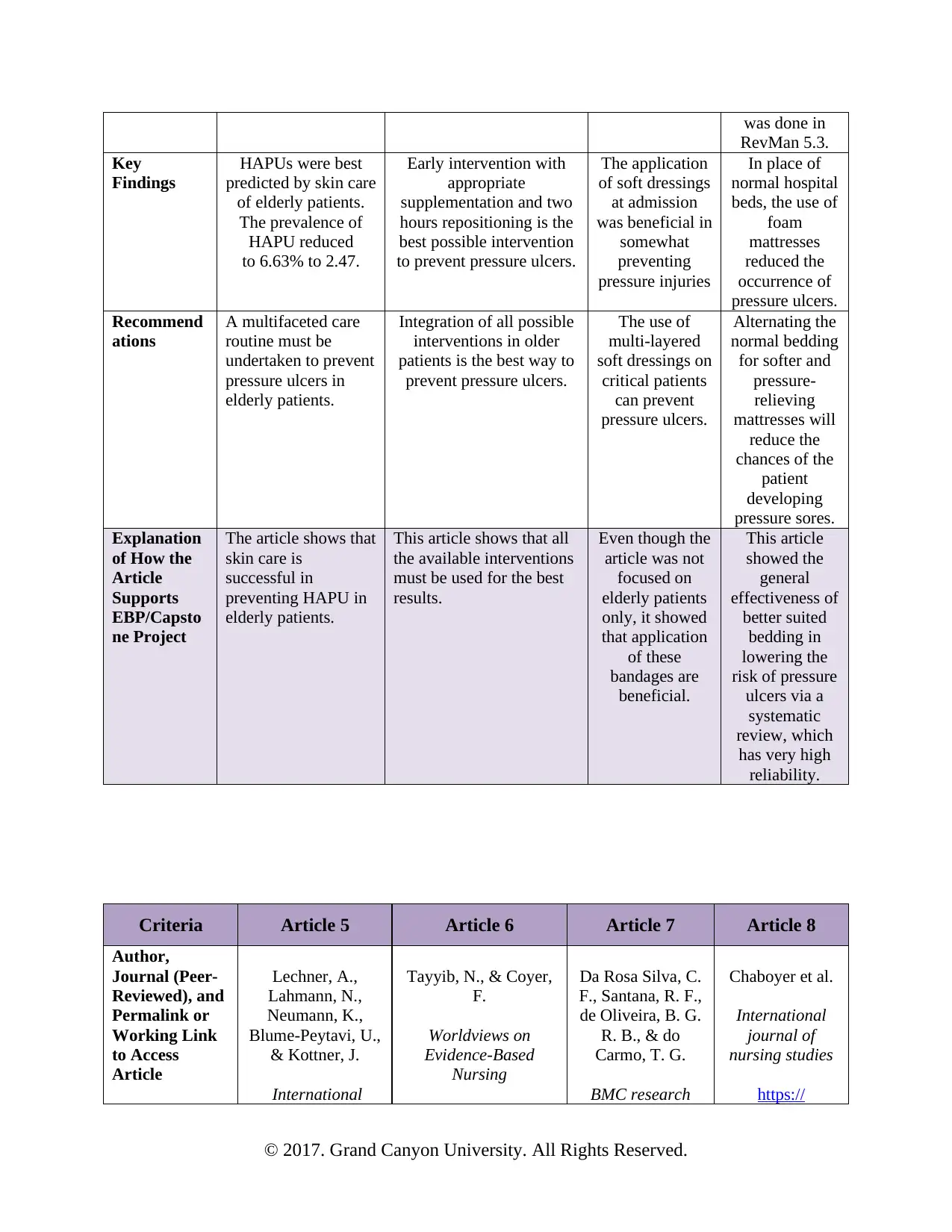
was done in
RevMan 5.3.
Key
Findings
HAPUs were best
predicted by skin care
of elderly patients.
The prevalence of
HAPU reduced
to 6.63% to 2.47.
Early intervention with
appropriate
supplementation and two
hours repositioning is the
best possible intervention
to prevent pressure ulcers.
The application
of soft dressings
at admission
was beneficial in
somewhat
preventing
pressure injuries
In place of
normal hospital
beds, the use of
foam
mattresses
reduced the
occurrence of
pressure ulcers.
Recommend
ations
A multifaceted care
routine must be
undertaken to prevent
pressure ulcers in
elderly patients.
Integration of all possible
interventions in older
patients is the best way to
prevent pressure ulcers.
The use of
multi-layered
soft dressings on
critical patients
can prevent
pressure ulcers.
Alternating the
normal bedding
for softer and
pressure-
relieving
mattresses will
reduce the
chances of the
patient
developing
pressure sores.
Explanation
of How the
Article
Supports
EBP/Capsto
ne Project
The article shows that
skin care is
successful in
preventing HAPU in
elderly patients.
This article shows that all
the available interventions
must be used for the best
results.
Even though the
article was not
focused on
elderly patients
only, it showed
that application
of these
bandages are
beneficial.
This article
showed the
general
effectiveness of
better suited
bedding in
lowering the
risk of pressure
ulcers via a
systematic
review, which
has very high
reliability.
Criteria Article 5 Article 6 Article 7 Article 8
Author,
Journal (Peer-
Reviewed), and
Permalink or
Working Link
to Access
Article
Lechner, A.,
Lahmann, N.,
Neumann, K.,
Blume-Peytavi, U.,
& Kottner, J.
International
Tayyib, N., & Coyer,
F.
Worldviews on
Evidence‐Based
Nursing
Da Rosa Silva, C.
F., Santana, R. F.,
de Oliveira, B. G.
R. B., & do
Carmo, T. G.
BMC research
Chaboyer et al.
International
journal of
nursing studies
https://
© 2017. Grand Canyon University. All Rights Reserved.
RevMan 5.3.
Key
Findings
HAPUs were best
predicted by skin care
of elderly patients.
The prevalence of
HAPU reduced
to 6.63% to 2.47.
Early intervention with
appropriate
supplementation and two
hours repositioning is the
best possible intervention
to prevent pressure ulcers.
The application
of soft dressings
at admission
was beneficial in
somewhat
preventing
pressure injuries
In place of
normal hospital
beds, the use of
foam
mattresses
reduced the
occurrence of
pressure ulcers.
Recommend
ations
A multifaceted care
routine must be
undertaken to prevent
pressure ulcers in
elderly patients.
Integration of all possible
interventions in older
patients is the best way to
prevent pressure ulcers.
The use of
multi-layered
soft dressings on
critical patients
can prevent
pressure ulcers.
Alternating the
normal bedding
for softer and
pressure-
relieving
mattresses will
reduce the
chances of the
patient
developing
pressure sores.
Explanation
of How the
Article
Supports
EBP/Capsto
ne Project
The article shows that
skin care is
successful in
preventing HAPU in
elderly patients.
This article shows that all
the available interventions
must be used for the best
results.
Even though the
article was not
focused on
elderly patients
only, it showed
that application
of these
bandages are
beneficial.
This article
showed the
general
effectiveness of
better suited
bedding in
lowering the
risk of pressure
ulcers via a
systematic
review, which
has very high
reliability.
Criteria Article 5 Article 6 Article 7 Article 8
Author,
Journal (Peer-
Reviewed), and
Permalink or
Working Link
to Access
Article
Lechner, A.,
Lahmann, N.,
Neumann, K.,
Blume-Peytavi, U.,
& Kottner, J.
International
Tayyib, N., & Coyer,
F.
Worldviews on
Evidence‐Based
Nursing
Da Rosa Silva, C.
F., Santana, R. F.,
de Oliveira, B. G.
R. B., & do
Carmo, T. G.
BMC research
Chaboyer et al.
International
journal of
nursing studies
https://
© 2017. Grand Canyon University. All Rights Reserved.
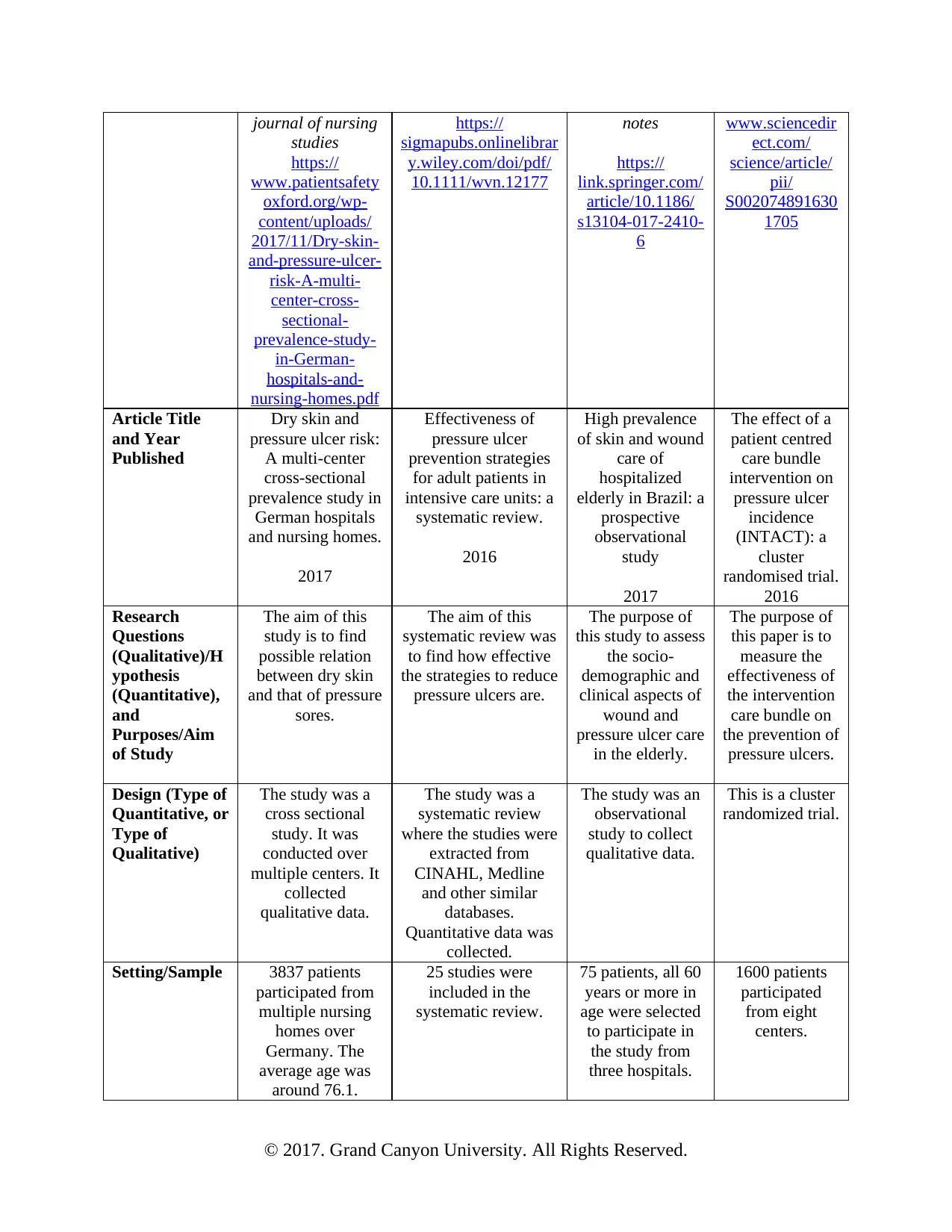
journal of nursing
studies
https://
www.patientsafety
oxford.org/wp-
content/uploads/
2017/11/Dry-skin-
and-pressure-ulcer-
risk-A-multi-
center-cross-
sectional-
prevalence-study-
in-German-
hospitals-and-
nursing-homes.pdf
https://
sigmapubs.onlinelibrar
y.wiley.com/doi/pdf/
10.1111/wvn.12177
notes
https://
link.springer.com/
article/10.1186/
s13104-017-2410-
6
www.sciencedir
ect.com/
science/article/
pii/
S002074891630
1705
Article Title
and Year
Published
Dry skin and
pressure ulcer risk:
A multi-center
cross-sectional
prevalence study in
German hospitals
and nursing homes.
2017
Effectiveness of
pressure ulcer
prevention strategies
for adult patients in
intensive care units: a
systematic review.
2016
High prevalence
of skin and wound
care of
hospitalized
elderly in Brazil: a
prospective
observational
study
2017
The effect of a
patient centred
care bundle
intervention on
pressure ulcer
incidence
(INTACT): a
cluster
randomised trial.
2016
Research
Questions
(Qualitative)/H
ypothesis
(Quantitative),
and
Purposes/Aim
of Study
The aim of this
study is to find
possible relation
between dry skin
and that of pressure
sores.
The aim of this
systematic review was
to find how effective
the strategies to reduce
pressure ulcers are.
The purpose of
this study to assess
the socio-
demographic and
clinical aspects of
wound and
pressure ulcer care
in the elderly.
The purpose of
this paper is to
measure the
effectiveness of
the intervention
care bundle on
the prevention of
pressure ulcers.
Design (Type of
Quantitative, or
Type of
Qualitative)
The study was a
cross sectional
study. It was
conducted over
multiple centers. It
collected
qualitative data.
The study was a
systematic review
where the studies were
extracted from
CINAHL, Medline
and other similar
databases.
Quantitative data was
collected.
The study was an
observational
study to collect
qualitative data.
This is a cluster
randomized trial.
Setting/Sample 3837 patients
participated from
multiple nursing
homes over
Germany. The
average age was
around 76.1.
25 studies were
included in the
systematic review.
75 patients, all 60
years or more in
age were selected
to participate in
the study from
three hospitals.
1600 patients
participated
from eight
centers.
© 2017. Grand Canyon University. All Rights Reserved.
studies
https://
www.patientsafety
oxford.org/wp-
content/uploads/
2017/11/Dry-skin-
and-pressure-ulcer-
risk-A-multi-
center-cross-
sectional-
prevalence-study-
in-German-
hospitals-and-
nursing-homes.pdf
https://
sigmapubs.onlinelibrar
y.wiley.com/doi/pdf/
10.1111/wvn.12177
notes
https://
link.springer.com/
article/10.1186/
s13104-017-2410-
6
www.sciencedir
ect.com/
science/article/
pii/
S002074891630
1705
Article Title
and Year
Published
Dry skin and
pressure ulcer risk:
A multi-center
cross-sectional
prevalence study in
German hospitals
and nursing homes.
2017
Effectiveness of
pressure ulcer
prevention strategies
for adult patients in
intensive care units: a
systematic review.
2016
High prevalence
of skin and wound
care of
hospitalized
elderly in Brazil: a
prospective
observational
study
2017
The effect of a
patient centred
care bundle
intervention on
pressure ulcer
incidence
(INTACT): a
cluster
randomised trial.
2016
Research
Questions
(Qualitative)/H
ypothesis
(Quantitative),
and
Purposes/Aim
of Study
The aim of this
study is to find
possible relation
between dry skin
and that of pressure
sores.
The aim of this
systematic review was
to find how effective
the strategies to reduce
pressure ulcers are.
The purpose of
this study to assess
the socio-
demographic and
clinical aspects of
wound and
pressure ulcer care
in the elderly.
The purpose of
this paper is to
measure the
effectiveness of
the intervention
care bundle on
the prevention of
pressure ulcers.
Design (Type of
Quantitative, or
Type of
Qualitative)
The study was a
cross sectional
study. It was
conducted over
multiple centers. It
collected
qualitative data.
The study was a
systematic review
where the studies were
extracted from
CINAHL, Medline
and other similar
databases.
Quantitative data was
collected.
The study was an
observational
study to collect
qualitative data.
This is a cluster
randomized trial.
Setting/Sample 3837 patients
participated from
multiple nursing
homes over
Germany. The
average age was
around 76.1.
25 studies were
included in the
systematic review.
75 patients, all 60
years or more in
age were selected
to participate in
the study from
three hospitals.
1600 patients
participated
from eight
centers.
© 2017. Grand Canyon University. All Rights Reserved.
Secure Best Marks with AI Grader
Need help grading? Try our AI Grader for instant feedback on your assignments.
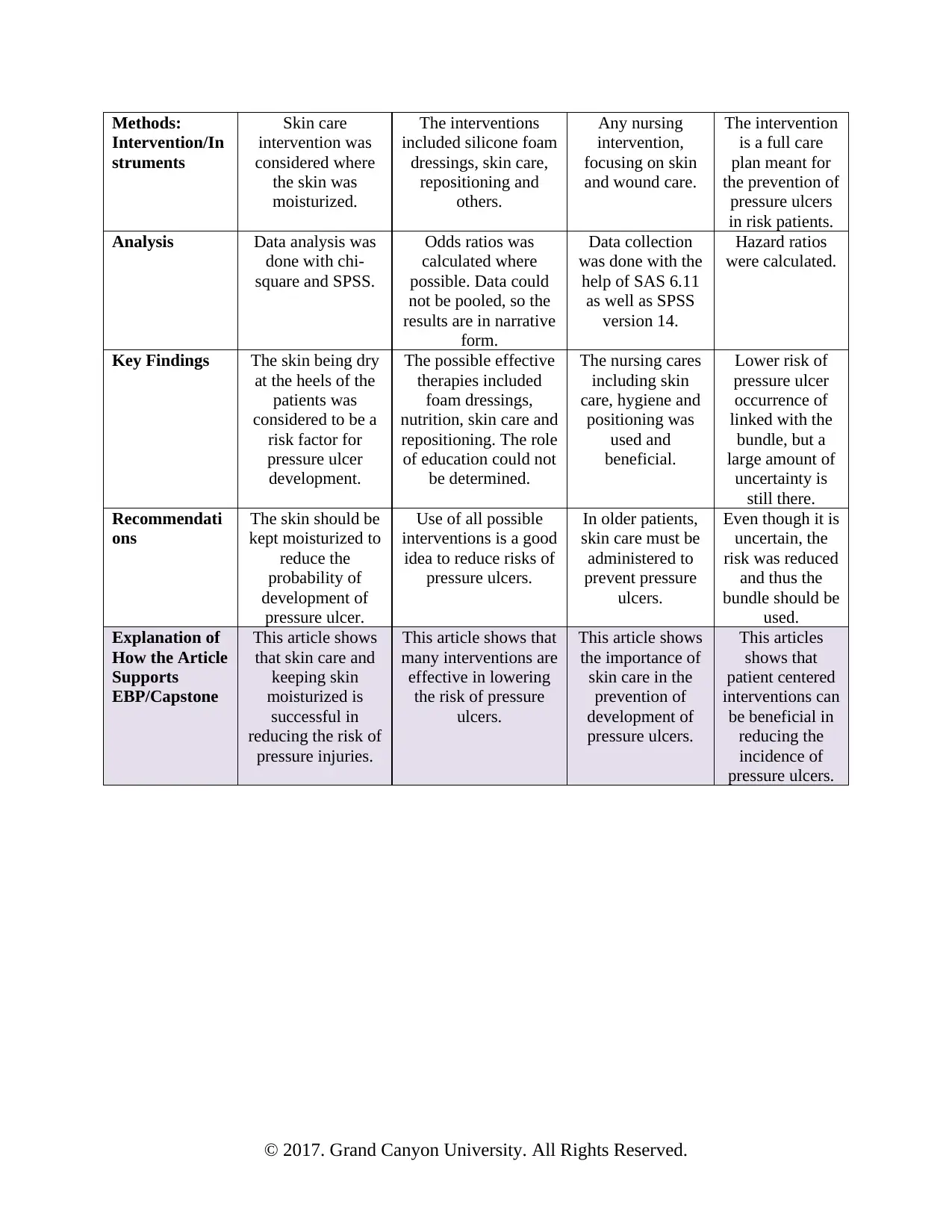
Methods:
Intervention/In
struments
Skin care
intervention was
considered where
the skin was
moisturized.
The interventions
included silicone foam
dressings, skin care,
repositioning and
others.
Any nursing
intervention,
focusing on skin
and wound care.
The intervention
is a full care
plan meant for
the prevention of
pressure ulcers
in risk patients.
Analysis Data analysis was
done with chi-
square and SPSS.
Odds ratios was
calculated where
possible. Data could
not be pooled, so the
results are in narrative
form.
Data collection
was done with the
help of SAS 6.11
as well as SPSS
version 14.
Hazard ratios
were calculated.
Key Findings The skin being dry
at the heels of the
patients was
considered to be a
risk factor for
pressure ulcer
development.
The possible effective
therapies included
foam dressings,
nutrition, skin care and
repositioning. The role
of education could not
be determined.
The nursing cares
including skin
care, hygiene and
positioning was
used and
beneficial.
Lower risk of
pressure ulcer
occurrence of
linked with the
bundle, but a
large amount of
uncertainty is
still there.
Recommendati
ons
The skin should be
kept moisturized to
reduce the
probability of
development of
pressure ulcer.
Use of all possible
interventions is a good
idea to reduce risks of
pressure ulcers.
In older patients,
skin care must be
administered to
prevent pressure
ulcers.
Even though it is
uncertain, the
risk was reduced
and thus the
bundle should be
used.
Explanation of
How the Article
Supports
EBP/Capstone
This article shows
that skin care and
keeping skin
moisturized is
successful in
reducing the risk of
pressure injuries.
This article shows that
many interventions are
effective in lowering
the risk of pressure
ulcers.
This article shows
the importance of
skin care in the
prevention of
development of
pressure ulcers.
This articles
shows that
patient centered
interventions can
be beneficial in
reducing the
incidence of
pressure ulcers.
© 2017. Grand Canyon University. All Rights Reserved.
Intervention/In
struments
Skin care
intervention was
considered where
the skin was
moisturized.
The interventions
included silicone foam
dressings, skin care,
repositioning and
others.
Any nursing
intervention,
focusing on skin
and wound care.
The intervention
is a full care
plan meant for
the prevention of
pressure ulcers
in risk patients.
Analysis Data analysis was
done with chi-
square and SPSS.
Odds ratios was
calculated where
possible. Data could
not be pooled, so the
results are in narrative
form.
Data collection
was done with the
help of SAS 6.11
as well as SPSS
version 14.
Hazard ratios
were calculated.
Key Findings The skin being dry
at the heels of the
patients was
considered to be a
risk factor for
pressure ulcer
development.
The possible effective
therapies included
foam dressings,
nutrition, skin care and
repositioning. The role
of education could not
be determined.
The nursing cares
including skin
care, hygiene and
positioning was
used and
beneficial.
Lower risk of
pressure ulcer
occurrence of
linked with the
bundle, but a
large amount of
uncertainty is
still there.
Recommendati
ons
The skin should be
kept moisturized to
reduce the
probability of
development of
pressure ulcer.
Use of all possible
interventions is a good
idea to reduce risks of
pressure ulcers.
In older patients,
skin care must be
administered to
prevent pressure
ulcers.
Even though it is
uncertain, the
risk was reduced
and thus the
bundle should be
used.
Explanation of
How the Article
Supports
EBP/Capstone
This article shows
that skin care and
keeping skin
moisturized is
successful in
reducing the risk of
pressure injuries.
This article shows that
many interventions are
effective in lowering
the risk of pressure
ulcers.
This article shows
the importance of
skin care in the
prevention of
development of
pressure ulcers.
This articles
shows that
patient centered
interventions can
be beneficial in
reducing the
incidence of
pressure ulcers.
© 2017. Grand Canyon University. All Rights Reserved.
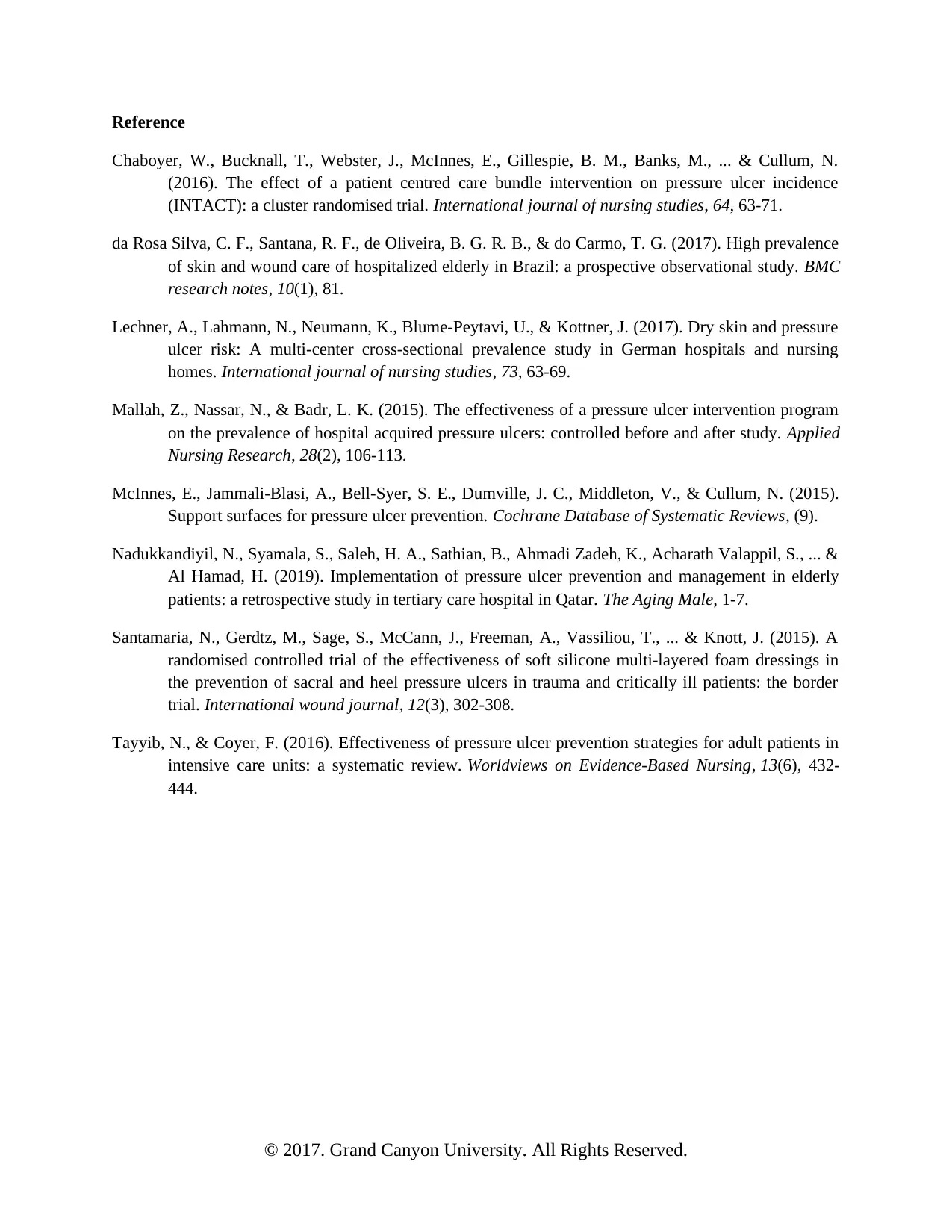
Reference
Chaboyer, W., Bucknall, T., Webster, J., McInnes, E., Gillespie, B. M., Banks, M., ... & Cullum, N.
(2016). The effect of a patient centred care bundle intervention on pressure ulcer incidence
(INTACT): a cluster randomised trial. International journal of nursing studies, 64, 63-71.
da Rosa Silva, C. F., Santana, R. F., de Oliveira, B. G. R. B., & do Carmo, T. G. (2017). High prevalence
of skin and wound care of hospitalized elderly in Brazil: a prospective observational study. BMC
research notes, 10(1), 81.
Lechner, A., Lahmann, N., Neumann, K., Blume-Peytavi, U., & Kottner, J. (2017). Dry skin and pressure
ulcer risk: A multi-center cross-sectional prevalence study in German hospitals and nursing
homes. International journal of nursing studies, 73, 63-69.
Mallah, Z., Nassar, N., & Badr, L. K. (2015). The effectiveness of a pressure ulcer intervention program
on the prevalence of hospital acquired pressure ulcers: controlled before and after study. Applied
Nursing Research, 28(2), 106-113.
McInnes, E., Jammali‐Blasi, A., Bell‐Syer, S. E., Dumville, J. C., Middleton, V., & Cullum, N. (2015).
Support surfaces for pressure ulcer prevention. Cochrane Database of Systematic Reviews, (9).
Nadukkandiyil, N., Syamala, S., Saleh, H. A., Sathian, B., Ahmadi Zadeh, K., Acharath Valappil, S., ... &
Al Hamad, H. (2019). Implementation of pressure ulcer prevention and management in elderly
patients: a retrospective study in tertiary care hospital in Qatar. The Aging Male, 1-7.
Santamaria, N., Gerdtz, M., Sage, S., McCann, J., Freeman, A., Vassiliou, T., ... & Knott, J. (2015). A
randomised controlled trial of the effectiveness of soft silicone multi‐layered foam dressings in
the prevention of sacral and heel pressure ulcers in trauma and critically ill patients: the border
trial. International wound journal, 12(3), 302-308.
Tayyib, N., & Coyer, F. (2016). Effectiveness of pressure ulcer prevention strategies for adult patients in
intensive care units: a systematic review. Worldviews on Evidence‐Based Nursing, 13(6), 432-
444.
© 2017. Grand Canyon University. All Rights Reserved.
Chaboyer, W., Bucknall, T., Webster, J., McInnes, E., Gillespie, B. M., Banks, M., ... & Cullum, N.
(2016). The effect of a patient centred care bundle intervention on pressure ulcer incidence
(INTACT): a cluster randomised trial. International journal of nursing studies, 64, 63-71.
da Rosa Silva, C. F., Santana, R. F., de Oliveira, B. G. R. B., & do Carmo, T. G. (2017). High prevalence
of skin and wound care of hospitalized elderly in Brazil: a prospective observational study. BMC
research notes, 10(1), 81.
Lechner, A., Lahmann, N., Neumann, K., Blume-Peytavi, U., & Kottner, J. (2017). Dry skin and pressure
ulcer risk: A multi-center cross-sectional prevalence study in German hospitals and nursing
homes. International journal of nursing studies, 73, 63-69.
Mallah, Z., Nassar, N., & Badr, L. K. (2015). The effectiveness of a pressure ulcer intervention program
on the prevalence of hospital acquired pressure ulcers: controlled before and after study. Applied
Nursing Research, 28(2), 106-113.
McInnes, E., Jammali‐Blasi, A., Bell‐Syer, S. E., Dumville, J. C., Middleton, V., & Cullum, N. (2015).
Support surfaces for pressure ulcer prevention. Cochrane Database of Systematic Reviews, (9).
Nadukkandiyil, N., Syamala, S., Saleh, H. A., Sathian, B., Ahmadi Zadeh, K., Acharath Valappil, S., ... &
Al Hamad, H. (2019). Implementation of pressure ulcer prevention and management in elderly
patients: a retrospective study in tertiary care hospital in Qatar. The Aging Male, 1-7.
Santamaria, N., Gerdtz, M., Sage, S., McCann, J., Freeman, A., Vassiliou, T., ... & Knott, J. (2015). A
randomised controlled trial of the effectiveness of soft silicone multi‐layered foam dressings in
the prevention of sacral and heel pressure ulcers in trauma and critically ill patients: the border
trial. International wound journal, 12(3), 302-308.
Tayyib, N., & Coyer, F. (2016). Effectiveness of pressure ulcer prevention strategies for adult patients in
intensive care units: a systematic review. Worldviews on Evidence‐Based Nursing, 13(6), 432-
444.
© 2017. Grand Canyon University. All Rights Reserved.
1 out of 6
Related Documents
Your All-in-One AI-Powered Toolkit for Academic Success.
+13062052269
info@desklib.com
Available 24*7 on WhatsApp / Email
![[object Object]](/_next/static/media/star-bottom.7253800d.svg)
Unlock your academic potential
© 2024 | Zucol Services PVT LTD | All rights reserved.





